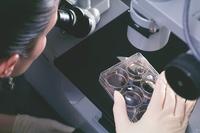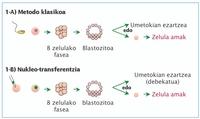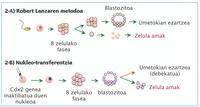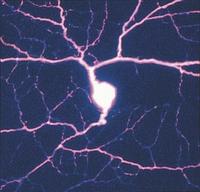New stem cell development techniques
2005/12/01 Orive Arroyo, Gorka - Farmazian doktorea. Biofarmazia, Farmakozinetika eta Farmazia-teknologiako irakasle kolaboratzaileaFarmazia Fakultatea UPV-EHU, Vitoria-Gasteiz Iturria: Elhuyar aldizkaria

Stem cells have the ability to become any type of body cell or develop any tissue, so they are so special and important. Because of this capacity, researchers believe that they are useful for the treatment of many diseases, such as Parkinson's or Alzheimer's, or for the production of body tissue.
So far, scientists knew two techniques for developing embryonic stem cells, but unfortunately serious ethical and religious problems and concerns have arisen. The main argument of the concerns is that obtaining stem cells involves the destruction or death of the embryo. Political forces have not been left out of that debate and have imposed severe prohibitions. For example, Germany does not admit to working with embryonic stem cells developed since 2002, and no studies working with cells developed since 2001 are subsidized in the United States.
Recently, the prestigious scientific journal Nature has published articles on two new stem cell development techniques. In this way the ethical, political and religious debate that has arisen is to be extinguished, since, according to the authors, it is not necessary to destroy embryos in any of them. To what extent is it true? Will they get rid of all their concerns? Time will tell.
First methods


Scientists have used two strategies to obtain stem cells from embryos, the classical method and nuclear transfer.
In the classical method, once the sex cells of man and woman are mixed -- sperm and egg -- the fertilized egg is formed. The fertilised cell begins to separate slowly, becoming a set of eight cells (balstomer) and forming at one point in the process a structure called blastozist. This classic method consists of extracting blastocyst cells and obtaining stem cells after maintaining them in the growth medium.
The blastocyst is also called "implantable embryo" because it is able to create an embryo if it is placed in the woman's uterus (Figure 1-A). Therefore, in this strategy, the extraction and use of blastocyst cells prevents the creation of a child. All the ethical and political debates it generates are based on this.

The kernel transfer method does not use sperm. The starting point is an unfertilized obocyte. The core is removed and the core of an adult is inserted. Thus, this new nucleus contains all chromosomes and is pushed into the blastocyst cell phase. Then, as in the previous method, there is the possibility of obtaining stem cells (Figure 1-B).
In addition, stem cells obtained by nuclear transfer contain the same genetic material as the nucleus donor. Therefore, the tissues or organs developed from these stem cells are perfectly compatible with the donor and do not generate rejection. Implantation in the uterus of blasts obtained through this system and the development of the child is called human cloning and is currently strictly prohibited.
New roads
In recent times, the journal Nature has published information on two new procedures for obtaining stem cells. One of them has been led by the team of Robert Lanza, who works at Advanced Cell Technology. Lanza and her team dominate the reproductive techniques of the laboratory well and, taking into account ethical and political concerns, have designed a new strategy for stem cell development. For this purpose they have taken as base the blaster, structure of eight cells that is formed in the development of the embryo.
Precisely, to look for the genetic defects of the embryo, one of the blaster cells is cleared and analyzed. Thus, Lanza thought that this single blastomer cell could be used for the development of stem cells and that the other seven cells could be used for the formation of the embryo (Figure 2-A). Through this new technique, the growth of the isolated blaster cell in an appropriate medium allows obtaining stem cells capable of developing any tissue.
Meanwhile, researchers Meissner and Jaenisch, who work at MIT Massachusetts (Massachusetts Institute of Technology), have unveiled a new strategy that has created blastocysts with no possibility of developing embryos with the latest advances in biology and genetics.

Researchers have called their 'altered core transfer' strategy by introducing some changes to the basic nuclear transfer technique. As can be seen in Figure 2-B, the first steps to follow until obtaining the blastocinate are equal to the transfer of nucleus, but once obtained this phase, they extinguish or deactivate a gene called Cdx2 with the help of a virus vector. This gene is essential for the formation of the placenta that performs mother-embryo interactions, so once disabled, embryo development from this blastozist will not be possible. However, this blastozist maintains the ability to produce stem cells for what researchers want to use.
Weak expectations
For some, these two techniques have brought some light to the infinite tunnel of stem cell research. However, each new procedure has generated new concerns and problems. In the strategy proposed by Lanza, it is not possible to obtain stem cells compatible with any patient, which reduces its therapeutic use. In addition, there are scientists who are not very clear whether this technique that has been demonstrated with animals can serve in humans, especially because instead of applying the eight-cell structure will work with a seven-cell structure.

On the other hand, the method proposed by Meissner and Jaenisch generates the same ethical concerns as the first. And the blastocyst, before changing genetically, has the ability to produce embryo, which only loses after the inactivation of the gene. So how to ethically justify the deactivation of this gene?
After analyzing the opinions of several experts, it seems that the method proposed by Lanza is more appropriate or that at least it will have fewer ethical barriers. The next step will be to achieve hopeful results with mice with human cells. It is probably only a matter of time, and researchers believe that eventually a true light will emerge on the path of stem cells. Until then these methods must be taken with hope but also with patience.




